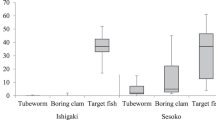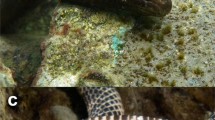Abstract
Field observations on feeding and related behavior of the mimic blennyAspidontus taeniatus and 3 species closely related to it, and the cleaner fish (model)Labroides dimidiatus were made at the coral reef of Sesoko Island, Okinawa, Japan, along with analysis of gut contents. The mimic blenny fed mostly on demersal eggs of fishes and tentacles of polychaetes, but it rarely tore pieces from the fins of host fishes even when they were posing for cleaning. The feeding habits of the mimic blenny are compared with those in other localities and with those of related species. It is concluded that the mimicry can hardly be regarded as an aggressive one: posing by host fishes seems to be a secondary result of the resemblance which may have developed because of the benefit for immunity from predation, and the resemblance itself prevents the blenny from becoming a specialized fin-eater because it can be easily recognized by host fishes.
Similar content being viewed by others
References
Eibl-Eibesfeldt, I. 1959 Der FischAspidontus taeniatus als Nachahmer des PutzersLabroides dimidiatus.Z. Tierpsychol. 16:19–26.
Hiatt, R. W. & D. W. Strasburg 1960 Ecological relationships of the fish fauna on coral reefs of the Marshall Islands.Ecol. Monogr. 30:65–127.
Kuwamura, T. 1976 Different responses of inshore fishes to the cleaning wrasse,Labroides dimidiatus, as observed in Sirahama.Publ. Seto Mar. Biol. Lab. 23:119–144.
Kuwamura, T. 1980 Cleaning symbiosis among marine organisms at the shallow rocky reefs in Shirahama.Nanki Seibutu 22:29–32 (in Japanese)
Kuwamura, T. 1981a Life history and population fluctuation in the labrid fish,Labroides dimidiatus, near the northern limit of its range.Publ. Seto Mar. Biol. Lab. 26:95–117.
Kuwamura, T. 1981b Mimicry of the cleaner wrasseLabroides dimidiatus by the blenniesAspidontus taeniatus andPlagiotremus rhinorhynchos.Nanki Seibutu 23:61–70. (in Japanese with English summary)
Kuwamura, T. Social structure of the protogynous fishLabroides dimidiatus. Publ. Seto Mar. Biol. Lab. (in press).
Losey, G. S. 1974a Cleaning symbiosis in Puerto Rico with comparison to the tropical Pacific.Copeia 1974:960–970.
Losey, G. S. 1974bAspidontus taeniatus: effects of increased abundance on cleaning symbiosis with notes on pelagic dispersion andA. filamentosus (Pisces, Blenniidae).Z. Tierpsychol. 34:430–435.
Losey, G. S. 1978 The symbiotic behavior of fishes. In: D. I. Mostofsky (ed.)The behavior of fish and other aquatic animals pp. 1–31. Academic Press, N.Y.
Nishihira, M. 1974 Oceanographical conditions around Sesoko Island, Okinawa.Ecol. Stud. Nat. Cons. Ryukyu Isls. 1:195–200. (in Japanese with English summary)
Okuno, R. 1969a Cleaning behaviors of the rainbow wrasse,Labroides dimidiatus. I.Jap. J. Ecol. 19:184–191. (in Japanese with English synopsis)
Okuno, R. 1969b Cleaning behaviors of the rainbow wrasse,Labroides dimidiatus. II.Jap. J. Ecol. 19:217–222. (in Japanese with English synopsis)
Potts, G. W. 1973 The ethology ofLabroides dimidiatus (Cuv. & Val.) (Labridae, Pisces) on Aldabra.Anim. Behav. 21:250–291.
Randall, J. E. 1958 A review of the labrid fish genusLabroides, with descriptions of two new species and notes on ecology.Pac. Sci. 12:327–347.
Randall, J. E. & H. A. Randall 1960 Examples of mimicry and protective resemblance in tropical marine fishes.Bull. Mar. Sci. Gulf & Caribb. 10:444–480.
Robertson, D. R. 1972 Social control of sex reversal in a coral-reef fish.Science 177:1007–1009.
Russell, B. C., G. R. Allen & H. R. Lubbock 1976 New cases of mimicry in marine fishes.J. Zool. Lond. 180:407–423.
Smith-Vaniz, W. F. 1976 The saber-toothed blennies, tribe Nemophini (Pisces: Blenniidae).Acad. Nat. Sci. Philadelphia, Mongr. 19:1–196.
Springer, V. G. & W. F. Smith-Vaniz 1972 Mimetic relationships involving fishes of the family Blenniidae.Smithsonian Cont. Zool. (112):1–36.
Wickler, W. 1960 Aquarienbeobachtungen anAspidontus, einem ektoparasitischen Fisch.Z. Tierpsychol. 17:277–292.
Wickler, W. 1961 Über das Verhalten der BlenniidenRunula undAspidontus (Pisces, Blenniidae).Z. Tierpsychol. 18:421–440.
Wickler, W. 1963 Zum Problem der Signalbildung, am Beispiel der Verhaltens-mimikry zwischenAspidontus undLabroides (Pisces, Acanthopterygii).Z. Tierpsychol. 20:657–679.
Wickler, W. 1968 Mimicry in plants and animals. Weidenfeld and Nicolson, London, 225pp.
Yamamoto, T. 1979. Distribution and abundance ofEupomacentrus nigricans (Lacépède) (Pisces, Pomacentridae) in the Ryukyu Islands.Sesoko Mar. Sci. Lab. Tech. Rep. 6:3–32.
Yoshino, T. & S. Nishijima 1981 A list of fishes found around Sesoko Island, Okinawa.Sesoko Mar. Sci. Lab. Tech. Rep. 8:19–87.
Author information
Authors and Affiliations
About this article
Cite this article
Kuwamura, T. Reexamination on the aggressive mimicry of the cleaner wrasseLabroides dimidiatus by the blennyAspidontus taeniatus (Pisces; Perciformes). J. Ethol. 1, 22–33 (1983). https://doi.org/10.1007/BF02347828
Received:
Accepted:
Issue Date:
DOI: https://doi.org/10.1007/BF02347828




